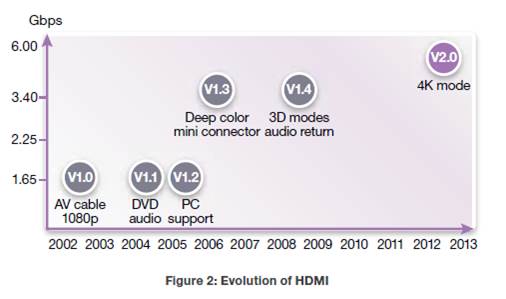High Definition Multimedia Interface (HDMI) is today part of our day to day life, at home as well as at our office we are using devices integrating HDMI ports. HDMI penetration is well illustrated by this picture (created in Dec. 2011 by In-Stat): from DTV to Game console, the devices belong to the Consumer Electronics market segments, and we are supposed to use it at home. But we extensively use Mobile phones and PC (and peripherals) at work, as well as camera and camcorder for marketing purpose. According with this forecast, almost one Billion HDMI devices will have been shipped this year!

If HDMI protocol is such a success, why the “HDMI Forum” has decided to specify HDMI 2.0? The main objective was to support an ultra-HD experience with 4096 x 2160 pixels, the “4K” resolution, allowing viewers to watch video on ever larger screen with high definition clarity. But some HDMI 2.0 features are pretty attracting too:
- HDMI 1.4 provided 10.2 Gbps aggregate (3 lanes at 3.4 Gbps) bandwidth, to support 4K x 2K Mode at 60 Hz and 24 bit color, you need: 18 Gbps aggregate bandwidth
- Transition-Minimized Data Scrambling (TMDS) is implemented (above 10.2 Gbps only, to support backward compatibility with HDMI 1.3 and 1.4) to reduce EMI
- New colorimetry format like YCbCr 4:2:0 offer a visual loss-less ultra-HD experience: don’t be confused by this “barbarian” name, such a format has been defined to provide a visual as close as possible to the human perception of colors!
- New 21:9 frame format for true cinema experience
- High-bandwidth Digital content Protection (HDCP) 2.2 for digital rights managements

If you want to know the full list of HDMI 2.0 features, I suggest you to read this excellent white paper from Synopsys: “How HDMI 2.0 Will Enrich the Multimedia Experience”.

It’s not really surprising to see that Synopsys is strongly involved in the new HDMI protocol version 2.0. IPNEST is monitoring the Interface IP market, including HDMI, since 2009. In the early days (2007-2010), Silicon Image was defining the standard, selling HDMI ASSP and also HDMI IP, collecting the royalties (through HDMI Licensing LLC.) and eventually running compliance testing of the protocol. Synopsys decided to penetrate HDMI IP market in 2010, and the company has developed PHY and Controller IP solution for HDMI 1.3, then 1.4 and now 2.0.

Because HDMI is considered as an additional feature to a large SoC, selling an integrated (PHY + Controller) solution was the winning strategy: a chip maker will not really differentiate by designing one or the other piece in-house. If you take a look at Synopsys web site, you will see that HDMI 2.0 IP includes the PHY, the Controller and even the Software. We don’t know the IP license revenues generated by HDMI for 2013, but I would not be surprised if Synopsys take the leadership –ranked before Silicon Image- in this segment. In fact, Synopsys has multiplied by 3 the HDMI IP license revenue between 2010 and 2012.

In the past, the semiconductor and electronics industry had some concerns with HDMI protocol: they had to pay royalties to HDMI LLC, but they could not influence the specifications. Until late 2011, HDMI LLC was a closed standard body that consisted in seven founders and over 1,000 adopters. The HDMI specification was architecture by the seven founders in a closed-door environment. In October 2011, the HDMI founders established a nonprofit corporation called HDMI Forum, with the purpose to foster broad industry participation in the development of future versions of the HDMI specification. The wide market penetration of HDMI protocol, covering every segment in Consumer Electronic, the consumer part of PC and Peripheral, the Mobile phone and even starting in Automotive segment, has made HDMI the de-facto standard for display technologies, and HDMI 2.0 the right solution for Ultra High-Definition Multimedia Experience.
From Eric Esteve from IPnest
More Articles by Eric Esteve …..
lang: en_US
Share this post via:








Comments
0 Replies to “Why integrating HDMI 2.0?”
You must register or log in to view/post comments.